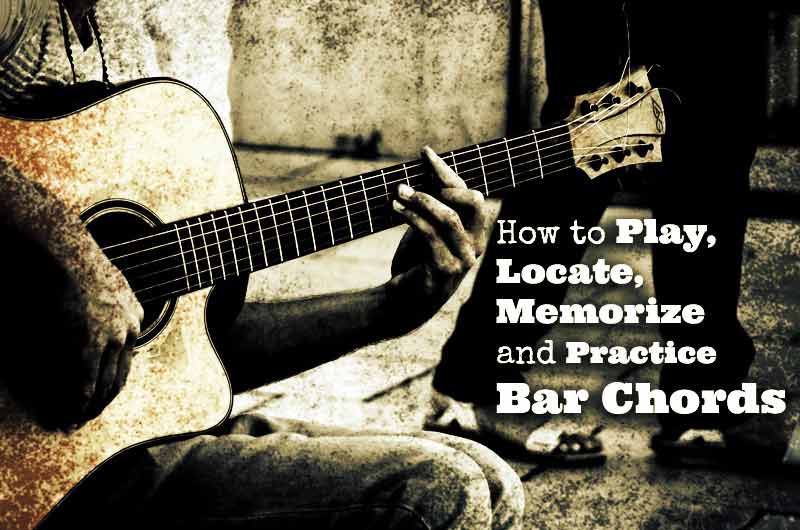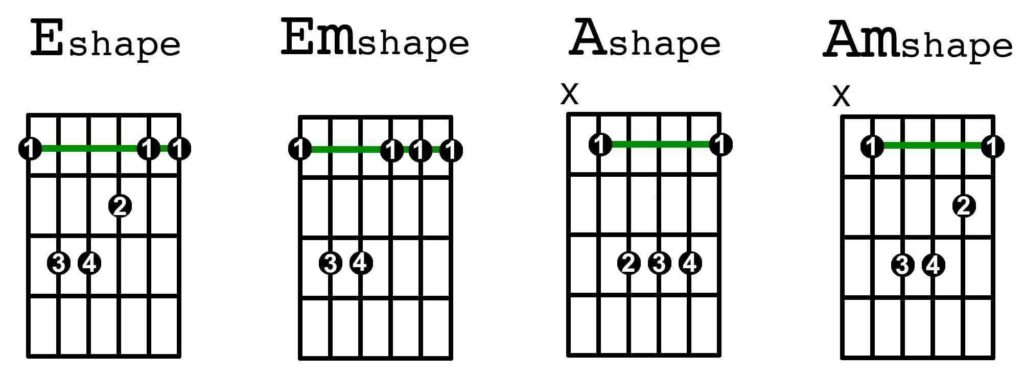September 20, 2019 by Klaus Crow

Once you know how to play bar chords, the next step is to learn how to instantly find, recognize and play every bar chord type all over the neck.
For that to happen you first have to locate, memorize and practice the four essential bar chord shapes (E major, E minor, A major and A minor) all over the fretboard in the most effective way.
- The E major shape bar chord indicates a barre (first finger) with an E major (shape) chord played with your 2nd, 3rd and 4th finger.
- The E minor shape bar chord indicates a barre with an E minor (shape) chord played with your 3rd and 4th finger.
- The A major shape bar chord indicates a barre with an A major (shape) chord played with your 2nd, 3rd and 4th finger.
- The A minor shape bar chord indicates a barre with an A minor(shape) chord played with your 2nd, 3rd and 4th finger. See diagrams below:

Major Bar Chords (E Major shape)
To find and recognize the names for all the E major shape bar chords you only have to memorize the natural notes on the low E-string, so no sharps (#) or flats (b). (See the neck diagram below).
Memorize the frets and their natural notes:
|1st fret = F | 3rd fr = G | 5 fr = A | 7 fr = B | 8 fr = C |10 fr = D |12 fr = E |

These are 7 natural notes and on each fret starts a bar chord with the same name. For example, when you play an E shape bar chord starting on the 3rd fret where the G note is located on the Low E-string, your chord also is called G major. When you play the E shape bar chord on the 8th fret you’re chord is now called a C major chord and so on. See diagrams below (The chord shape moves up and the chord name changes with it).

Sharps (♯) and Flats (♭)
Now you know where the natural notes are located it’s super easy to find bar chords with sharps and flats. For example: Where is F# on the fretboard? Well, sharp chords are only 1 fret higher than the original chord, so F# is 1 fret higher than F. In other words, F major chord (E shape based) is on the 1st fret , so F# is on the 2nd fret.
So, where is the G# chord? G# is 1 fret higher than G. G is on the 3rd fret, so G# is next to it on the 4th fret, and so on.
Flat chords (♭) are only 1 fret lower than the original chord. For example: Where is Bb? Bb is 1 fret lower than B. B (E-shape based) is on the 7th fret, so Bb is on the 6th fret. Where is Gb? G is on the 3rd, so Gb is on the 2nd fret , and so on.
Minor Bar Chords (E minor shape)
Now you’ve memorized the 7 locations of the natural notes you can also easily switch from major to minor bar chords. You know that an E major shape bar chord on the 3rd fret is a G major chord, but if you play an E minor shape bar chord it becomes a G minor chord. That goes for every key. If you play an E minor shape chord on the 8th fret you’re now playing C minor, and so on. You easily switch from major to minor.

Major Bar chords (A Major shape)
For the A major shape bar chord you only have to memorize the natural notes on the A-string. For example: Start your A shape bar chord on the 2nd fret and you have a B major chord. Start your A shape bar chord on the 7th fret and you have an E major chord.
Memorize the frets and their natural notes:
|1st fret = B | 3rd fr = C | 5 fr = D | 7 fr = E | 8 fr = F |10 fr = G |12 fr = A |


Minor Bar chords (A minor shape)
The switch from major to minor also applies to the A shape bar chord. If you play the A minor shape bar chord on the 3rd fret it becomes a Cm. If you play a Am shape bar chord on the 8th fret it becomes an Fm chord.

More E – Em – A – Am shape bar chord types
You can also easily play other chord types and move them across the fretboard using one and the same bar chord shape and transpose to other keys.
For instance, if you move F7 (E-shape) to the 3rd fret and you get G7, move Fm6 (Em-shape) to the 3rd fret you get Gm6. Move B7 (A-shape) to the 5th fret you get D7, move Bm7 (Am-shape) to the 5th fret you get Dm7, and so on. Let’s take a look at some of those other bar chord types:


How to practice:
- Practice simple chord songs with bar chords using both E / Em shape and A / Am shape bar chords. You can play any chord song you like, but instead of using open chords you play bar chords. First start with three chord songs and gradually build your way up to 4, 5 and 6 chord songs or more.
- To memorize the name and the location of every bar chord instantly and without hesitation, always speak the name out loud of each bar chord you play when practicing a song. This is the way to memorize the chord names thoroughly. Skip this and you will keep fooling around.
- Once you’re comfortable playing 4 and 5 chord songs you can practice songs that contain other chord types like sus2, sus4, dom7, and minor7 and major7 chords.
- Play the game. Question yourself randomly which bar chord is located on what fret. What E-shape and A-shape bar chord is located on the 5th fret? Answer: A and D. What Em-shape and Am-shape bar chord is located on the 10th fret? Answer: Dm and Gm. Now you try.
- Also reverse the question. On what frets are the G bar chords (E-shape and A-shape) located? Answer: 3rd fret and 10th fret. On what frets are the D#minor chords (Em-shape and Am-shape) located? Answer: 11th fret and 6th fret. Now test yourself with some chords of your own. You can practice this everywhere at anytime.
- Practice the game with other chord types as well. Test yourself randomly. Play a G7 in E-shape and A-shape. Play a Cm7 in Em-shape and Am-shape. Play a Bsus4 in E-shape and A-shape.
- Finally make your bar chords sound clean and clear and practice the following exercises: Effective Exercises To Make Barre Chords Sound Clean
Have fun with it!
Hey there Klaus,
I was just working on bar chords. This article is coming at just the right time.
Thanks a great deal.
Donna
Hi Donna,
Great to hear that. Bar chords is the next step in rhythm playing.
It opens up a new world of musical possibilities on the guitar.
It’s challenging in the beginning but just keep at it and soon you will discover its benefits.
Best,
Klaus Crow
Thank you so much , I was working on the bar chords and it helped a lot
Great explanation and very well written.
This is a really helpful article. Thank you so much for sharing